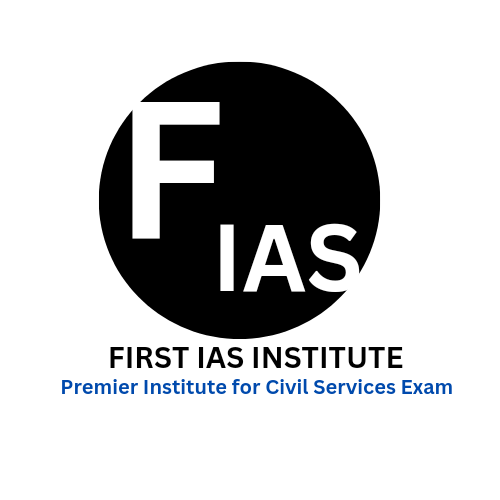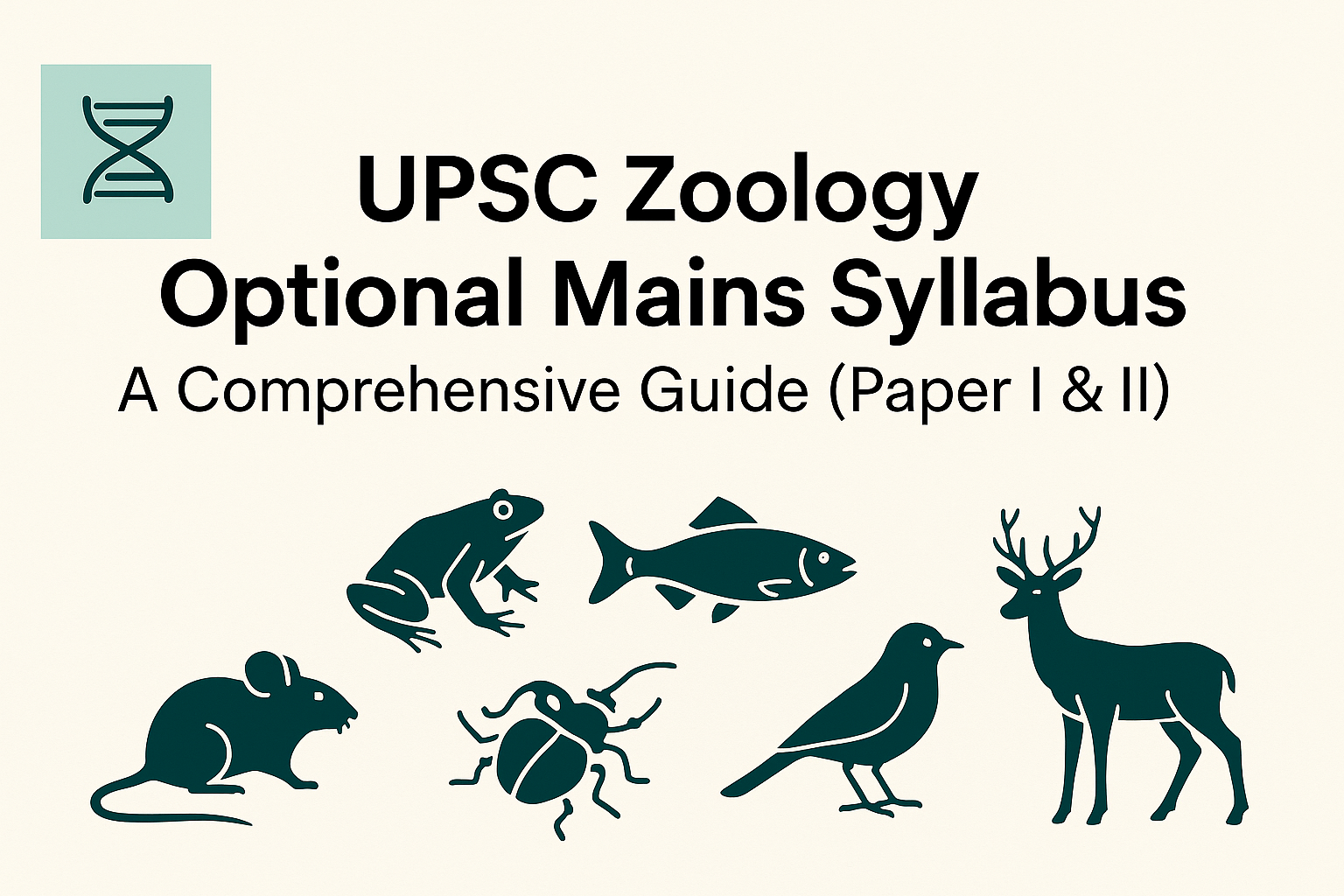UPSC Zoology Optional Mains Syllabus: A Comprehensive Guide (Paper I & II)
Zoology is a favored optional subject for many UPSC aspirants with a background in life sciences, medicine, or veterinary sciences. It is a scientific and analytical subject, offering clarity in preparation due to its defined syllabus. This blog breaks down the Zoology Optional syllabus for UPSC Mains into Paper I and Paper II, based on the latest UPSC notification, with detailed descriptions for better understanding and strategic preparation.
Join WhatsApp community for Free Notifications, Updates, Study Material, Mock Tests, Internship Updates, and Current Affairs - CLICK HERE TO JOIN
Paper I: Non-Chordata, Chordata & Cell Biology
Section A: Non-Chordata and Chordata
1. Classification and Relationship of Major Animal Phyla
- General and comparative account of the following:
- Coelom: Acoelomate, pseudocoelomate, coelomate conditions
- Symmetry: Radial, bilateral, and asymmetry
- Segmentation and Metamerism
- Basis of classification (developmental and molecular)
- Evolutionary relationship among phyla based on body plan and embryology
2. Protozoa to Hemichordata
- Protozoa:
- Locomotion, reproduction, and parasitic protozoans (e.g., Plasmodium)
- Porifera:
- Canal system, spicules, and their significance
- Coelenterata:
- Polymorphism, coral reefs, metagenesis
- Platyhelminthes:
- Parasitic adaptations, life cycle of Fasciola and Taenia
- Nematoda:
- Ascaris and filarial worm, their impact on human health
- Annelida:
- Coelom, segmentation, nephridia, and locomotion
- Arthropoda:
- Larval forms, metamorphosis, and economic importance (e.g., honey bee, silkworm)
- Mollusca:
- Torsion and detorsion in gastropods, pearls
- Echinodermata:
- Water vascular system, larval forms
- Hemichordata:
- Affinities with chordates and non-chordates
3. Chordata
- General characters and classification of Chordates
- Comparative anatomy of the following:
- Integumentary System
- Skeletal System
- Digestive System
- Respiratory System
- Circulatory System
- Excretory System
- Reproductive System
- Adaptive features in:
- Fishes (e.g., air bladder, scales)
- Amphibians (e.g., dual mode of life)
- Reptiles (e.g., excretion, thermoregulation)
- Birds (e.g., flight adaptation)
- Mammals (e.g., hair, mammary glands)
To Enroll in FIRST IAS INSTITUTE - Click Here
Section B: Cell Biology and Genetics
1. Cell Structure and Function
- Prokaryotic and eukaryotic cells
- Ultrastructure of:
- Plasma membrane
- Mitochondria
- Golgi apparatus
- Endoplasmic reticulum
- Lysosomes
- Ribosomes
- Cilia and flagella
- Nucleus:
- Nuclear membrane, nucleolus, and chromosomes
2. Cell Cycle and Cell Division
- Mitosis and meiosis – stages and significance
- Regulation of cell cycle
- Apoptosis – programmed cell death
3. Chromosomes and Gene Expression
- Chromosome structure – euchromatin and heterochromatin
- Types of chromosomes – sex chromosomes, autosomes
- DNA replication, transcription, and translation
- Gene regulation in prokaryotes and eukaryotes (e.g., operon model)
- Mutations – types and effects
4. Molecular Genetics and Techniques
- Genetic code, gene concept
- Recombinant DNA technology
- PCR, blotting techniques (Southern, Northern, Western)
- Cloning vectors, gene therapy basics
Join WhatsApp community for Free Notifications, Updates, Study Material, Mock Tests, Internship Updates, and Current Affairs - CLICK HERE TO JOIN
Paper II: Physiology, Developmental Biology, Ecology, and Applied Zoology
Section A: Physiology and Biochemistry
1. Physiology of Animals (with special reference to mammals)
- Blood and Circulation:
- Composition, blood groups, coagulation, heart physiology
- Respiration:
- Mechanism of gas exchange, oxygen transport
- Excretion:
- Structure and function of kidney, urine formation
- Nervous System:
- Neurons, impulse conduction, reflex action
- Endocrinology:
- Hormones of pituitary, thyroid, adrenal, pancreas
- Feedback mechanism in hormone regulation
- Muscle Physiology:
- Types of muscles, mechanism of contraction
- Reproduction:
- Gametogenesis, menstrual cycle, fertilization
2. Biochemistry
- Carbohydrates, proteins, lipids – structure, metabolism
- Enzymes:
- Classification, kinetics, factors affecting activity
- Vitamins and coenzymes
- Metabolic pathways:
- Glycolysis, Krebs cycle, oxidative phosphorylation
To Enroll in FIRST IAS INSTITUTE - Click Here
Section B: Developmental Biology, Ecology & Applied Zoology
1. Embryology and Developmental Biology
- Gametogenesis and fertilization
- Types of eggs and patterns of cleavage
- Blastulation and gastrulation
- Development of vertebrates: Frog and Chick
- Extra-embryonic membranes and placenta
- Organizer concept and morphogen gradients
- Regeneration, metamorphosis, and teratogenesis
- Stem cells and assisted reproductive technologies (IVF, cloning)
2. Ecology and Ethology
- Ecosystems: Structure and energy flow, food chain/web, ecological pyramids
- Population ecology: Growth models, survivorship curves
- Community ecology: Succession, species diversity
- Biodiversity:
- Conservation strategies, wildlife protection acts
- Ethology:
- Animal behavior, communication, learning, and social organization
- Role of hormones in behavior
3. Applied Zoology
- Economic Zoology:
- Apiculture, sericulture, lac culture, aquaculture, vermiculture
- Pest control:
- Biological and integrated pest management
- Animal Husbandry:
- Dairy and poultry farming, livestock breeding
- Zoonotic Diseases:
- Causes, transmission, and control (e.g., rabies, anthrax)
- Wildlife conservation:
- Endangered species, national parks, sanctuaries
- Forensic Zoology:
- Role of insects and animals in crime detection
Join WhatsApp community for Free Notifications, Updates, Study Material, Mock Tests, Internship Updates, and Current Affairs - CLICK HERE TO JOIN
Final Thoughts: Why Choose Zoology?
Zoology as an optional is scientific and factual, with limited scope for subjective interpretation. It offers:
- Clear and defined syllabus
- Overlap with GS papers in ecology and environment
- Good scoring potential with diagrams and illustrations
- Especially helpful for students from zoology, medical, or life science backgrounds


 firstiasofficial@gmail.com
firstiasofficial@gmail.com
Leave a Comment